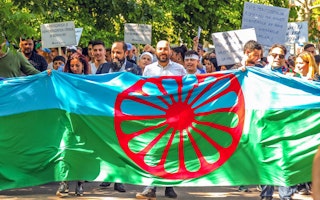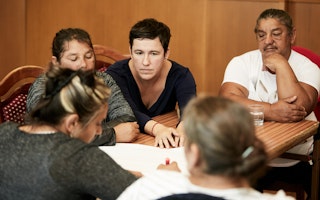Roma: In Search of A Balanced Image
By Anna Mirga

The image of Roma is one of the major obstacles to progress. When you think about us, say, in Slovakia, perhaps you think only of horrifying pictures of a segregated population—a people walled off from the rest of society. All Roma are portrayed as living a terrible life which, in fact, some of them do.
But you might be surprised to learn that at least half the Roma living in Slovakia are actually integrated among the majority population—attending schools, working, paying their taxes, and contributing to the society among which they live. In Slovakia, numerous political groups frame the Roma issue in terms of problems, for example, that the Roma are dominant in using (and also misusing) social welfare provisions.
The data demonstrates the opposite—in fact, Roma are only a quarter of all people who receive social payments. But such data rarely makes it to the first page news, buried under the anti-Roma rhetoric, not only in Slovakia but also throughout Europe.
The negative picture of Roma is the one that big international organizations too often want you to see. International bodies, like the World Bank and the UNDP, well-intentionally aim to point out the critical situation for a significant portion of Roma. The other part of the picture—that of integrated Roma, proud of their identity and valuable to society as citizens and members of an ethnic minority—is forgotten.
But I am Roma, and I recognize that this is partly our fault. We have helped create a negative image for the community. We connect the Roma with problems, with poverty, marginalization, and discrimination in order to build a sense of urgency that will motivate governments to act.
We self-stigmatize. We self-victimize. It´s counterproductive. By problematizing the issue, we problematize our own ethnic identity. In order to regain a sense of self-respect and pride and promote a more positive picture of Roma, it is important for us to show that there are people who are happy with their identity, and who add value to their society. If we try to construct a counter-narrative based on a dignified discourse about Roma culture, everybody would benefit.
As Roma activists, we realize our own deficiencies and challenges. We need to engage more in a process of self-reflection and self-criticism—to try to identify what has worked, and what hasn’t. Organizations working on behalf of the Roma need to evolve. Roma organizations frequently undertake the role of providing services, often substituting for the responsibilities of the state. Too often in policy consultation, Roma groups are there merely to legitimize the process, without being a critical voice and making their claims heard.
Roma organizations need to become active agents of change, guided by a strategic long-term thinking and not by the agendas marked by donors and governments. We need strong and democratic structures to take more of a role in community building—creating a space where people can interact, network, and nurture hope. Some of the Roma organizations throughout Europe are already doing this, but it seems that everyone is working separately in their own backyard. We, as activists, need to increasingly engage in an internal dialogue where we exchange ideas, share knowledge and, most importantly, search for a common agenda and a united voice—bringing strength and a coordinated vision, to be able to speak in unison.
Don’t get me wrong. There is discrimination, persecution. There are hate crimes perpetrated against the Roma people. And the support from big international organizations has been much appreciated—and crucial to the progress made.
But sometimes, it seems the European Union and other donors are just throwing money at the problems, without achieving real and much-needed impact. Our role, as activists and organizations, is crucial in the process of reshaping the way in which the money allocated for Roma inclusion is invested.
Our expertise and experience are invaluable, but in that we need to nurture our critical and independent voice. We need to work for better communication between governmental bodies and the Roma locally, based on real partnership and dialogue. We need to act as watchdogs, to weigh the evidence, evaluate programs, and monitor progress in order to improve the way money is allocated for the Roma.
The problem is particularly acute during economic downturns. Poverty becomes overwhelming, and we forget about the importance of building ties with other sectors of the society and with the majority as a whole. Many of the problems we as Roma are facing are shared by other minorities, immigrant communities or socio-economically marginalized groups.
Many of the predicaments of a significant portion of Roma are rooted in structural inequalities, power-class relations, increasingly intolerant and discriminatory societies—problems that are not inherently and exclusively related to Roma. While anti-Gypsyism is a reality, we need to realize that some of this anti-Roma rhetoric is directly linked to the image of Roma—framed in terms of poverty and uselessness.
Nonetheless, Roma activists and organizations are increasingly capable of targeting these issues. Over the years, our communities and their local groups had to learn by doing. When we started out, we didn’t have the know-how we have today.
My generation can build on what has been done before, combining the experience and wisdom of the senior leaders with knowledge and energy of the youth. Yes, people have to struggle day to day just to survive, communities are trapped in a vicious circle of poverty and many Roma NGOs are on the verge of closure. But with sustained support of independent donors, Roma activists can develop a vision, a plan to get beyond the day-to-day struggles. These organizations should be the source of inspiration for identity-building.
Maybe we can steer the conversation to be less about “the Roma problem” and more about the value of the Roma people—as productive citizens who maintain their culture and take pride in their roots. Of course, the picture is far from perfect, but the number of Roma attending school is growing steadily today. We are looking at the best-educated generation of Roma in history.
With increasing numbers of young, educated Roma, we are observing a qualitative change in Roma civil society. Against all odds, I am hopeful for the future.
Anna Mirga is a Roma activist from Poland, a PhD student at the Autonomous University of Barcelona, and a fellow with the Open Society Roma Initiatives Office.


